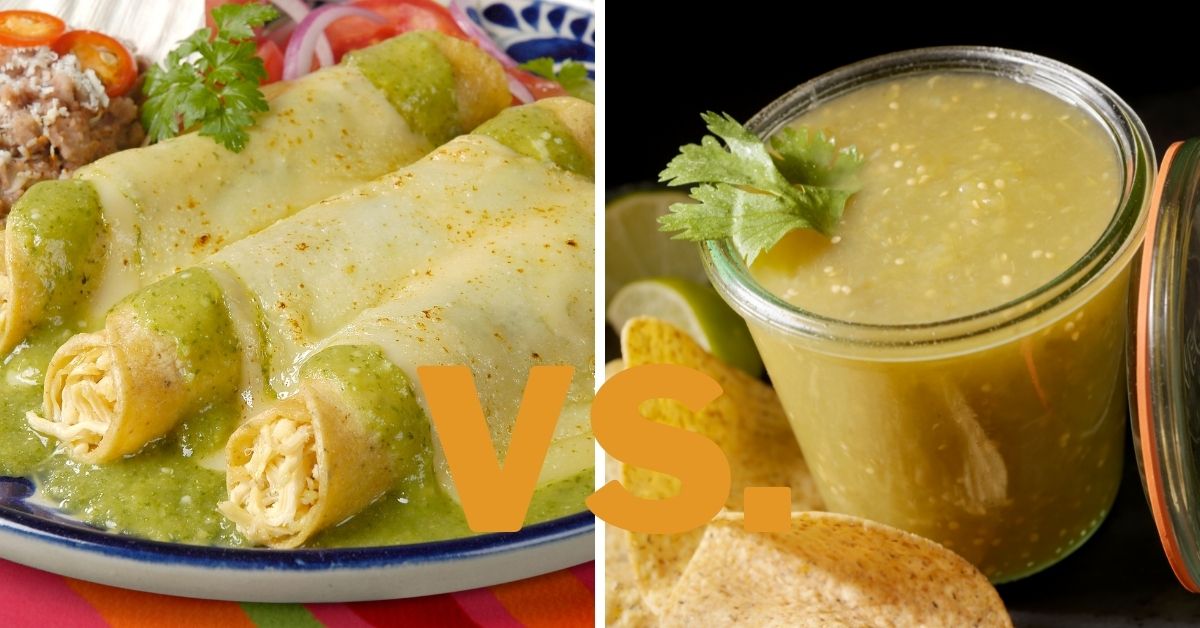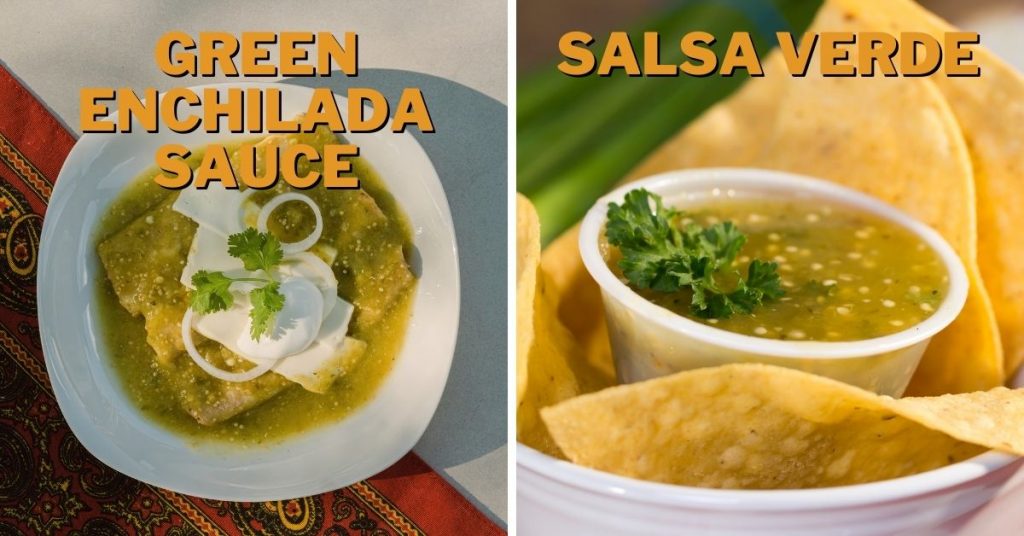Green Enchilada Sauce vs. Salsa Verde: Differences & Which Is Better?

Two products that can be confused are green enchilada sauce and salsa verde. There are many ways to prepare them, and sometimes it isn’t easy to understand the differences. This is because some ingredients are the same but used in different quantities. So what is the difference between green enchilada sauce and salsa verde?
In a green enchilada sauce, the main ingredients are baked and peeled chiles and raw jalapeño. While in salsa verde, the main ingredients are boiled (or baked) tomatillos. Those ingredients can affect the taste of both sauces. Enchilada sauce is spicier and salsa verde is acidic and herby.
Below I will try to explain in the most precise ways the differences from the way of preparing to the taste, nutrition, price, and how to use each of them separately and together.
Green Enchilada Sauce vs. Salsa Verde: Differences
Taste
The most significant similarity between those two sauces is the green color. This is influenced by the green vegetables present. But, despite the similarity in color, the tastes are different. In salsa verde, the most dominant veggie is tomatillos. Tomatillos may create you the impression that they are similar tomatoes. They are a completely different product.
They are very bitter and acidic, with some herbal smell presence. After cooking, the acidity and bitterness are felt less, but they are still there. The taste is fresh, and depending on the quantity of the spices, it may also be spicy.
In enchilada sauce, the green color is caused by three elements: green chiles, jalapeño but also from tomatillos. In this sauce, the taste is spicier as it depends a lot on the type of chiles used. Olive oil presence also adds some good fat flavor.
Texture
In the green enchilada sauce, you need to add vegetable stock before blending. This makes the sauce smoother and homogeneous. As a result, the final product is thinner and of low viscosity.
A different technique is applied in salsa verde. In this case, you blend the mass without adding extra water or stocks. So, in the end, the sauce is pure cream, and it is thicker.
Uses
The different textures also affect the usage of those sauces. Because it’s thicker, salsa verde is perfect for fish tacos, burritos, and fajitas. But you can consume salsa verde with nachos as a dip for a quesadilla or to accompany scrambled eggs.
Another pleasant way to enjoy sauce is topping for meats or seafood. Meat and salsa verde make a perfect combo to create a fantastic flavor.
As I said before, enchilada sauce is more watery, so it’s not proper to be served as a potential sauce. Usually is more used to give a recipe the final touch, for example, for soups or dressings in meats or salads.
You can use this sauce with enchilada recipes, casserole, or enchilada rice. This is a perfect vegetarian sauce if you have used vegetable broth instead of chicken broth. In this case, it’s suitable to be consumed with grilled or roasted vegetables.

Ingredients
Some ingredients are the same in both sauces, but others are different. For example, the main green ingredients that cause the green color are different. The main ingredient for salsa verde is green tomatoes or tomatillos. For enchilada sauce, the main ingredients are green chiles.
Enchilada sauce also has white onion, while salsa verde has yellow onions. A mutual product of both is jalapeño, even though the quality changes. Both contain common ingredients like garlic and salt. The type of oil is not the same as enchilada sauce requires olive oil, and salsa verde has vegetable oil.
Enchilada has more spices, while salsa verde is more acidic due to lemon juice. You can add fresh cilantro if you like it in both of them.
Nutrition
In nutritional values, green enchilada sauce is not very high in calories, which is good and bad. Good because it means that you can consume it without fearing a calories bomb. But also, it may be considered a bad thing because you cannot count on this sauce to add a lot of health value to your meal.
For 100 grams of sauce, you will get 74 kcal. 1.47 grams of protein and fiber, 6.36 grams of carbohydrates, and 2.92 grams of sugars. Also, enchilada is rich in potassium, vitamin C and Iron. [1]
While salsa verde has fewer calories, only 38 kcal for 100 grams, the dominant macronutrients are carbs, 6.36 grams of sugar, and fibers 1.9 grams. It also contains vitamin C and Sodium, but less than in enchilada sauce. [2]
As you can see, they obtain almost the same macronutrients. Although in a green enchilada, nutritional values are higher than in salsa verde. This may be because of the variety of green vegetables.
Which One Is Easier to Make at Home?
I believe that time is the primary factor in determining the easiness of homemade food. Considering this, green enchilada needs more time to be prepared. This recipe may last up to 50 minutes.
For this recipe, green chiles need to be baked and peeled. After you saute with other ingredients and in the end, blend, all this may last up to 50 minutes.
While in salsa verde, you need to boil all ingredients together and then blend them. This recipe usually does not take more than 20-30 minutes. Although, if you decide to bake the tomatillos, this recipe may also take a while, so it depends on your choices.
Price
To compare prices, we need to consider factors such as brand or product type. Also, the brand’s positioning in the market can affect the price or if it’s organic or not.
When it comes to sauces, I always prefer to prepare them myself. But on rare occasions when needed to save time or lack of ingredients, buying them is also a good option.
One of the most famous and good brands of green enchilada sauce is Hatch. But, unfortunately, the price for one can be up to $5,9.
As per salsa verde, the price seems to be more than double enchilada sauce. For one can of salsa verde of brand Herdez, you will pay up to 14.344. The good organic versions will cost more than that due to the supreme quality.
Which One Is Creamier?
In cooking, the smoothness of a recipe depends on the quantities used. In the case of enchilada, the sauce is more homogeneous and juicy because it contains broth and olive oil.
On another note, salsa verde is in the form of vegetable puree after blending, so its texture is thicker. However, a high-quality blender can create an excellent creamy condition. If you are making it at home and it turns out too watery, don’t worry because there are always ways to thicken it.
Green Enchilada Sauce vs. Salsa Verde: Which Is Better?
It is not easy to determine which one is better, but I would say salsa verde as I prefer the thick and creamy version rather than juicy and watery. In addition, it is not that spicy, so it’s lighter for my stomach.
But for sure it depends on the point of view. For example, to fill fajitas or burritos is salsa verde, but to give a soup the last touch in green enchilada sauce.
The best for a low-calorie meal is salsa verde. Green enchilada sauce has more health benefits due to the higher content of vitamins.
Can You Substitute Salsa for Enchilada Sauce and Vice Versa?
You may have realized by now that the ingredients and techniques are pretty similar. Still, I don’t think it is good to interchange those sauces with each other.
Firstly, changing them won’t work due to their texture, and you will risk destroying the recipe. For example, enchilada sauce in tacos is not going to work. Enchilada sauce is juicy, so you won’t get the creamy bite while eating it than with salsa verde.
The same is true the other way around. If you put enchilada sauce in egg scrambles because of the consistency, you won’t have a good result.
Is Green Chili Enchilada Sauce the Same as Green Enchilada Sauce?
Green chili sauce and green enchilada sauce are almost the same but have some differences. In green enchilada sauce, you use flour to make it thicker. You also use jalapeno and cilantro, not added to the classic green chili enchilada sauce recipe.
Green chili sauce utilizes green chili instead of jalapenos. It doesn’t use cilantro but uses ginger for the extra spiciness.
